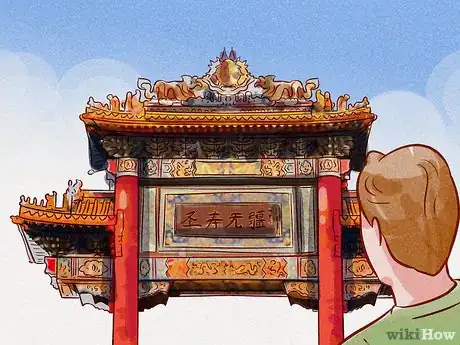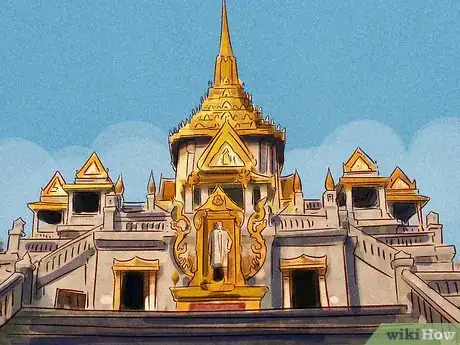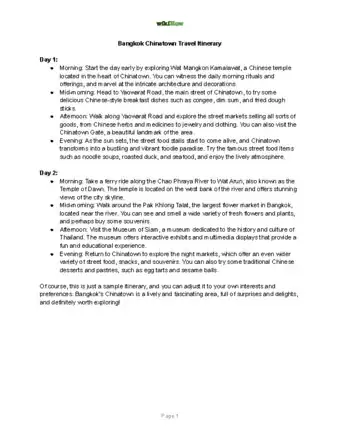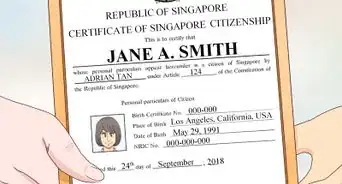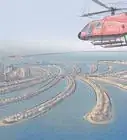This article was co-authored by wikiHow Staff. Our trained team of editors and researchers validate articles for accuracy and comprehensiveness. wikiHow's Content Management Team carefully monitors the work from our editorial staff to ensure that each article is backed by trusted research and meets our high quality standards.
There are 13 references cited in this article, which can be found at the bottom of the page.
This article has been viewed 39,062 times.
Learn more...
Bangkok’s Chinatown is one of the biggest Chinatowns in the world and is home to many unique sights. Although you don’t have a lot of direct options for getting to Chinatown, the public travel systems in Bangkok are fortunately traveler-friendly. Be prepared to walk or take transportation to appreciate the beautiful temples, delicious street food, and other attractions throughout the area.
Steps
Traveling to Chinatown
-
1Take a boat to Ratchawong Pier for a direct route to Chinatown. Bangkok has piers all along the Chao Phraya river. Travel to the nearest pier, then board a Chao Phraya River Express boat. Once you reach Ratchawong Pier, Chinatown is a short, straight walk ahead. River trips are scenic, but the boats sometimes feel crowded due to the number of other travelers.[1]
- The trip takes about 15 minutes and costs about 15 baht, less than $1.00 USD, although longer trips from more distant piers cost more.
- A boat trip is traditionally the quickest way to Chinatown. The piers have maps, schedules, and signs translated into English. You buy a ticket from an automated machine when you arrive at the pier.
- Many of the piers are near public transportation stations. Sathorn Pier, for example, is a short walk from the Saphan Taksin Skytrain stop.
-
2Use the Wat Mangkon subway stop if you need to reach Chinatown quickly. The Wat Mangkon stop is scheduled to open in September 2019. To reach it, find the nearest Mass Rapid Transit station in the city. Make sure it goes to Wat Mangkon via the MRT Blue Line. Then, get your ticket to ride the subway train into the heart of Chinatown.[2]
- The options for navigating to the Wat Mangkon will be limited at first, so traveling this way may be inconvenient depending on where you are in the city.
- The MRT works similarly to the piers. The stations are equipped with plenty of signs translated to English and automatic ticketing machines that are easy for travelers to navigate.
- Tickets start at 15 baht and increase depending on how many stations you pass on your trip.
Advertisement -
3Travel to Hua Lamphong station if you need an alternative subway route. Hua Lamphong station is on the southern edge of Chinatown. You will need to go to the closest MRT station and board the MRT Blue Line to reach it. Once you arrive, exit the station and walk north for about 15 minutes to reach Chinatown.[3]
- Walking from Hua Lamphong station is a good way to enjoy the sights of Chinatown on a warm day. Bring a map along to help you navigate.
-
4Take a taxi or tuk-tuk if you need assistance traveling. Taxis and tuk-tuks are the most expensive options for reaching Chinatown. To easily summon a taxi, wait by the side of any road and look for cabs with red lights. Tell the driver where you want to go, then negotiate the price with them. The taxis and tuk-tuks are very colorful, often green and yellow or red and blue, so they’re easy to spot.[4]
- Not all drivers are fair to tourists. Instruct the driver to use their taxi meter. If they disagree, they likely will attempt to overcharge you for the trip. There are many taxis, so wait for the next one.
- Tuk-tuks are basically motorized rickshaws. They’re like taxis meant for shorter distances. Be aware of drivers that claim to know secret shopping locations or offer tours, since this is a popular scam targeted at travelers.
- Most drivers don’t speak great English. In addition, the roads in Bangkok are often crowded, so your trip might be longer and costlier than you anticipate.
-
5Ride a bus for a cheaper way to travel by road. Go to the nearest bus station in the city and wave at an approaching bus to flag it down. Instead of buying a ticket in advance, you tell the driver where you want to go and pay as you board. The fare is between 7 to 20 baht depending on how far you need to travel. Keep a list of the important bus stops in Chinatown so you know when you need to get off the bus.[5]
- Bangkok’s bus system is pretty extensive and can be confusing for travelers, but the terminals in the city all have maps that will help you get around.
- The buses are numbered to indicate where they stop. Bus lines 1, 4, 7, 25, 53, and 73 are a few common options for getting to Chinatown.
- The buses are also color-coded. You may see buses that have the same number but are different colors. These buses often go on separate routes, so be careful when choosing your ride.
Packing for Chinatown
-
1Carry money to avoid transaction fees in Chinatown. Thailand’s currency is the baht, and having some on hand is useful especially if you plan on shopping. Visit your bank or the exchange counter at the airport. Get enough currency for your trip. Then, bring U.S. dollars or traveler’s checks as a backup currency.[6]
- Many places accept U.S. currency and even exchange it. A lot of hotels and other large businesses also take some credit cards for a small fee.
- Local ATMs are relatively easy to use if you speak English, but they charge a large transaction fee. Expect to pay around $6.00 for a transaction.
- Crime is pretty low in Chinatown. There are some pickpockets in the busy areas, but they won’t be able to get you if you’re aware of your surroundings.
-
2Take a map to help you navigate through the city. Although Bangkok is fairly visitor-friendly, the winding roads still get a little confusing at times. Chinatown is right on the banks of the Chao Phraya River, so using that as a landmark will help you determine your location on the map. Then, use the map to guide you to various stops on your trip.[7]
- The Chao Phraya River borders Chinatown to the south and west. Some other useful landmarks include the Prha Pokklao Road bridge to the southwest and the Sirat Expressway to the east.
-
3Bring a translation app if you don’t speak Thai. Road signs in Bangkok are printed in both English and Thai. However, a lot of the building signs, like marquees for tourist attractions, are printed only in Thai. Take a good translating tool like Google Translate or iTranslate with you to help you get around the city.[8]
- Bangkok is a relatively tourist-friendly city, but getting around is still tricky if English isn’t your first language. Find a good translation app for your primary language to make navigating easier.
- Thai is a difficult language to translate, so even the best apps aren’t perfect. Having a dictionary is also useful in case the app fails.
-
4Bring warm-weather clothing that isn’t too revealing. Bangkok isn’t too restrictive on what you’re allowed to wear. Most people wear shorts and a T-shirt to endure the warm weather, which averages about 87 °F (31 °C) in summer. Bring a pair of walking shoes to help you get around the city in comfort. As long as you don’t reveal excessive amounts of skin, you won’t have much trouble for the most part.[9]
- For example, avoid bringing short shorts and spaghetti strap-style shirts. If you visit a temple, you may be asked to cover up before you are allowed in.
- The further south you go, the more conservative the dress gets due to the sizable Muslim population in the city.
Touring Chinatown
-
1Take a bike tour to get around the city faster. Bike rentals are available at a few shops in the area. Another option is to book a tour with a travel agency. Paid tours often last as long as 3 hours. Biking is a good compromise between walking and taking a cab, the main ways of traveling within Chinatown.[10]
- Take the side roads when riding a bike. The side roads are much quieter and safer for bike traffic than the busy main streets.
-
2Use the Chinatown Gate as an entrance to the area. The gate is immediately visible when you approach Chinatown from the south. It’s a short walk directly west from Hua Lamphong station and a longer walk east from Ratchawong Pier. It’s an ornate, red arch marking the area as a tourist destination.[11]
- The gate is in the middle of the Odeon traffic circle. Both the gate and the road are often closed on holidays, but it is very busy during the Chinese New Year.
-
3Walk to Wat Traimit if you travel through Hua Lamphong. Wat Traimit is most likely the first tourist destination you will see when walking west from Hua Lamphong. It is across the road from the Chinatown Gate and is easily recognizable by its gold spire. This temple is known for having the world’s largest golden Buddha statue.
- The temple has a heritage museum on the second floor. The Buddha statue is on the third floor.
- Tickets cost between 40 to 100 baht and are available at a nearby kiosk.
-
4Visit Yaowarat and Sampeng if you wish to shop. Yaowarat Road and Charoen Krung Road branch off from the upper half of the Odeon traffic circle. Both roads feature tons of shops, restaurants, and food carts. Yaowarat Road leads to a large area to the west called Sampeng Market, which is a big but crowded shopping market filled with all sorts of goods.[12]
- Yaowarat Road is known for its gold shops. Some of the shops are well-known, but be wary of smaller stalls and shops that seem seedy.
- The roads and the market are typically very crowded, so be prepared for the heat and close quarters if you go.
-
5Visit Wat Mangkon Kamalawat if you enjoy learning about religion. Chinatown has a bunch of different Buddhist temples, but Wat Mangkon Kamalawat is one of the most prestigious in the world. It’s on the right side of Charoen Krung Road as you walk north from the Chinatown Gate. It’s free to visit and contains many relics and rituals related to Buddhism.[13]
- The temple sells items like paper notes to burn as an offering and is near a lot of street food vendors, making it very accessible.
- There are other temples, such as Wat Chakkrawat further west, closer to Ratchawong Pier. They are all similar but have a few different sights to see. Wat Chakkrawat, for instance, has crocodile ponds.
-
6Visit the Little India district if you need to escape the crowds. Little India is right on the western edge of Chinatown, north of the Phra Pokklao Bridge. It usually is not as crowded as the heart of Chinatown, although it has plenty of shops, restaurants, and Sikh temples. The nearby India Emporium Mall is a nice place to escape the heat for a moment or find something different from the rest of Bangkok.
- Little India is close to Sampeng Market, making it a natural stop after a long day of walking among the crowds of Chinatown.
Bangkok Chinatown Travel Itinerary
Warnings
- Taxi and tuk-tuk drivers sometimes try to take advantage of travelers. Some groups have formed what is known as the “taxi mafia,” which tries to scam tourists by promising to take them on personal tours. Avoid these offers to save your money.⧼thumbs_response⧽
Things You’ll Need
- Baht or alternative currency
- Warm-weather clothing
- A comfortable pair of walking shoes
- Translation app or dictionary
- Chinatown map
- Bus or subway route map
References
- ↑ https://www.youtube.com/watch?v=gGup1xaCr4c&feature=youtu.be&t=5
- ↑ https://www.scmp.com/lifestyle/travel-leisure/article/2141436/bangkoks-chinatown-braces-gentrification-now-subway-station
- ↑ https://www.youtube.com/watch?v=hQBrvKyDdjo&feature=youtu.be&t=10
- ↑ https://www.youtube.com/watch?v=-VZ8eX0d5KM&feature=youtu.be&t=24
- ↑ https://www.timeout.com/bangkok/things-to-do/discover-different-sides-of-bangkok-on-these-five-bus-routes
- ↑ https://liveandletsfly.boardingarea.com/2017/07/20/thailand-tourist-cash-requirement/
- ↑ https://www.travelfish.org/interactive-map-location/thailand/bangkok_and_surrounds/bangkok/chinatown
- ↑ https://theculturetrip.com/asia/thailand/articles/15-must-have-apps-for-living-in-bangkok/
- ↑ https://www.travelandleisure.com/travel-tips/packing-tips/what-to-pack-for-thailand










